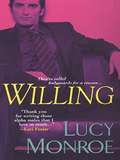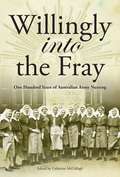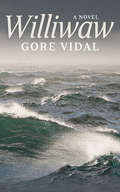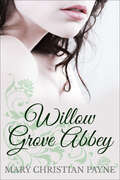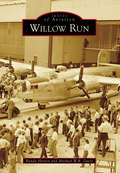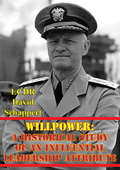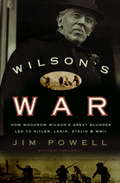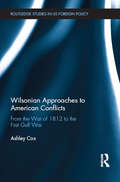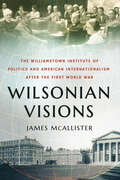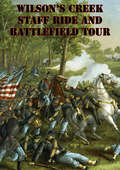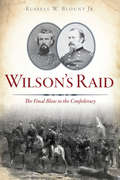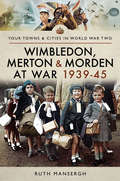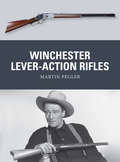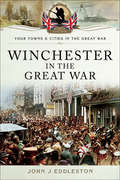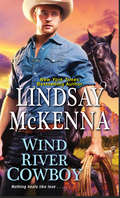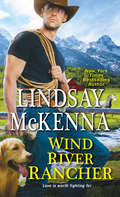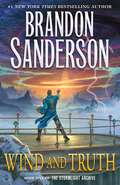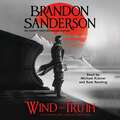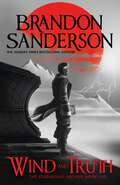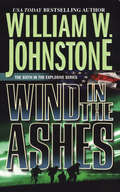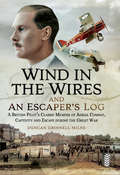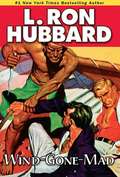- Table View
- List View
Willing
by Lucy MonroeThe bestselling author of Ready &“packs this story with heart-stopping action, sizzling romance and a plot that leaves you thinking&” (Romantic Times). Meet three sexy men taking on the bad guys at every turn. They&’ll get the job done—if the price is right and so is the cause . . . Josie McCall left her dad&’s mercenary school for a normal job in computers. But now that someone has torched the school and her dad is MIA, Josie&’s going to use every bit of her training to hunt down the culprits who took him. Josie knows a lot about explosives, hand-to-hand combat, and tracking. What she doesn&’t know about is sex. She has no idea what to do with the volcanic attraction she feels for her dad&’s new partner, Daniel Black Eagle. And that feels more dangerous than any bomb . . . Daniel knows exactly what he&’d like to do about that attraction. He can&’t get within five feet of Josie without wanting to touch, taste, and protect her. But right now he&’s got his hands full figuring out who set that bomb and took Josie&’s dad. Daniel&’s sure of one thing, though—he&’s not letting Josie McCall out of his sight for a single second . . . &“A very exciting romance novel, full of action and suspense.&” —Coffee Time Romance
Willingly into the Frey: One Hundred Years of Australian Army Nursing
by Catherine McCullaghWillingly into the Fray comprises the personal stories of sixty-five individual nurses, their voices preserved and their words, often fraught with emotion and mired in distress at what they have seen, endured and railed against, carefully retained. Many of these stories are told for the first time, particularly those of the recent campaigns, peacekeeping operations, disaster relief and humanitarian missions. These are men and women who, like those before them, often worked in the most primitive conditions, as one nurse remarked tellingly, ‘with TLC and little more’. It is typical of Australian Army nurses to proceed ‘willingly into the fray’, often with little warning, but always with courage, determination and a strong sense of humour. In the hundred or so years since the first intrepid Boer War nurses set out, Australian Army nurses have forged a proud and enviable reputation. They are justifiably renowned for their determination to provide quality medical care despite extreme privation, perilous circumstances, and a lack of the most rudimentary medical equipment. If this is the reputation they can forge in the face of such adversity, then we have much to look forward to over the next one hundred years. Willingly into the Fray provides a rare opportunity for the reader, to take a personal journey through the lives of Army nurses from the early days of 1899 to modern times, and to experience the vast changes in society that accompanied those hundred or so years.
Williwaw: Julian; Williwaw; The Judgement Of Paris; Messiah; The City; The Pillar
by Gore VidalWilliwaw first published in 1946, is the notable first novel of a young Gore Vidal, who during World War II was a first mate of a supply ship stationed in the Aleutian Islands. The story revolves around the small ship and her crew as they battle both the elements in the Bering Sea and the mounting tensions between some of the crew members. An intense wind—williwaw—strikes the ship, damaging the craft as she struggles to make her way back to port.
Willow Grove Abbey: A Historical World War II Romance Novel (Somerville Trilogy #1)
by Mary Christian PayneIn this epic tale of friendship, family, and romance in World War II England, a young noblewoman must choose between her inheritance and the man she loves.To many, Lady Sophia Somerville appears to live a privileged life. Still, it’s a life full of obstacles to be overcome . . .As a student at The Ashwick Park School, Sophia meets classmate Edwina Phillips. The two become the best of friends, but it is all put to the test by an unbelievable betrayal . . .Sophia’s debutante season is much anticipated. Yet when she falls in love with physician and RAF Group Captain Spencer Stanton, theirs is a relationship her parents cannot bless . . .Sophia’s parents appear to be the epitome of grace, charm and dignity, but that’s far from the truth. Her father is charismatic but unscrupulous, while her beautiful mother is prone to fits of rage. And as terrible as they may seem, Sophia still yearns for their approval—even as her values begin to turn away from theirs.Soon, long held family secrets emerge and threaten to destroy the Somervilles. Sophia is faced with an untenable decision: whether to hold fast to her beliefs and cut ties with her family or continue to be the dependent little girl her parents insist she is. Ultimately, Sophia must face the challenge of comprehending, forgiving, and loving her profoundly imperfect family.
Willow Run (Images of Aviation)
by Michael W.R. Davis Randy HottonIn May 1940, Pres. Franklin D. Roosevelt called for the production of 50,000 military airplanes. He then drafted the president of General Motors, William Knudsen, to mobilize industry in the United States. The automotive companies were called upon to produce a massive fleet of bombers, as well as tanks, trucks, guns, and engines. By the Willow Run, a sleepy little creek near Ypsilanti, Michigan, Ford Motor Company built the world's most famous bomber factory, which was the ultimate manifestation of the automotive industry's role in building armaments during World War II. By the spring of 1944, Willow Run was producing a four-engine B-24 bomber each hour on an assembly line. With tremendous assistance from the Yankee Air Museum, this book presents a pictorial history of Willow Run during World War II.
Willpower: A Historical Study Of An Influential Leadership Attribute
by Lcdr David SchappertThis thesis investigates a single leadership attribute: willpower. Willpower is defined as the amalgamation of continuing in the face of adversity; the refusal to accept failure; and the power to affect a desired outcome in others. The central research question investigates how a leader generates willpower and transmits it to produce a desired effect. The methodology employed investigates three historical military leaders at the strategic, operational, and tactical levels of war over a sixty year period. The leaders analyzed are General Colin Powell, Admiral Chester Nimitz, and Lieutenant General Harold Moore. This analysis method was chosen to answer the three secondary research questions: Is there a common thread? Is willpower different at different levels of war? Has willpower transmission changed over time? To provide objectivity, a leader who possessed willpower and still failed, General Douglas MacArthur, is also studied. The historical leaders studied are found to have similarities in how they generate and transmit willpower. The willpower transmission techniques employed by the research subjects have not changed significantly over the period studied. However, willpower transmission techniques do reveal differences over the three levels of war.
Wilson's War: How Woodrow Wilson's Great Blunder Led to Hitler, Lenin, Stalin, and World War Two
by Jim PowellThe fateful blunder that radically altered the course of the twentieth century--and led to some of the most murderous dictators in history President Woodrow Wilson famously rallied the United States to enter World War I by saying the nation had a duty to make "the world safe for democracy." But as historian Jim Powell demonstrates in this shocking reappraisal, Wilson actually made a horrible blunder by committing the United States to fight. Far from making the world safe for democracy, America's entry into the war opened the door to murderous tyrants and Communist rulers. No other president has had a hand--however unintentional--in so much destruction. That's why, Powell declares, "Wilson surely ranks as the worst president in American history. " Wilson's War reveals the horrifying consequences of our twenty-eighth president's fateful decision to enter the fray in Europe. It led to millions of additional casualties in a war that had ground to a stalemate. And even more disturbing were the long-term consequences--consequences that played out well after Wilson's death. Powell convincingly demonstrates that America's armed forces enabled the Allies to win a decisive victory they would not otherwise have won--thus enabling them to impose the draconian surrender terms on Germany that paved the way for Adolf Hitler's rise to power. Powell also shows how Wilson's naiveté and poor strategy allowed the Bolsheviks to seize power in Russia. Given a boost by Woodrow Wilson, Lenin embarked on a reign of terror that continued under Joseph Stalin. The result of Wilson's blunder was seventy years of Soviet Communism, during which time the Communist government murdered some sixty million people. Just as Powell's FDR's Folly exploded the myths about Franklin Roosevelt and the New Deal, Wilson's War destroys the conventional image of Woodrow Wilson as a great "progressive" who showed how the United States can do good by intervening in the affairs of other nations. Jim Powell delivers a stunning reminder that we should focus less on a president's high-minded ideals and good intentions than on the consequences of his actions. A selection of the Conservative Book Club and American Compass From the Hardcover edition.
Wilsonian Approaches to American Conflicts: From the War of 1812 to the First Gulf War (Routledge Studies in US Foreign Policy)
by Ashley CoxThis book explores US foreign policy, specifically the history of America’s entry into the War of 1812, the First World War, the Korean War and the First Gulf War. Using a historical case study approach, it demonstrates how the Wilsonian Framework can give us a unique understanding of why the United States chose to go to war in those four conflicts. Cox argues that the Wilsonian Framework is an important concern for decision makers in the US and that democracy promotion and the concept of international law are driving factors in each of these decisions to go to war. The realist and economic explanations of these conflicts are not sufficient and we must draw on Wilsonianism to gain a clear understanding of these conflicts. Drawing on the history of American liberalism and the work of Walter Russel Mead and Tony Smith, the book presents a definition of Wilsonianism that represents a broad span of the history of The Republic, in order to show consistency across time. It also establishes why the realist and economic explanations fail to provide sufficient explanatory power and how the Wilsonian Framework can give important insights into these conflicts. This book will be of interest to international historians and international relations scholars at both postgraduate and scholar level. It will also be of use to those wishing to conduct future research into the motivations that drive the foreign and security policies of the United States.
Wilsonian Visions: The Williamstown Institute of Politics and American Internationalism after the First World War
by James McAllisterIn Wilsonian Visions, James McAllister recovers the history of the most influential forum of American liberal internationalism in the immediate aftermath of the First World War: The Williamstown Institute of Politics. Established in 1921 by Harry A. Garfield, the president of Williams College, the Institute was dedicated to promoting an informed perspective on world politics even as the United States, still gathering itself after World War I, retreated from the Wilsonian vision of active involvement in European political affairs. Located on the Williams campus in the Berkshire Mountains of Western Massachusetts, the Institute's annual summer session of lectures and roundtables attracted scholars, diplomats, and peace activists from around the world. Newspapers and press services reported the proceedings and controversies of the Institute to an American public divided over fundamental questions about US involvement in the world. In an era where the institutions of liberal internationalism were just taking shape, Garfield's institutional model was rapidly emulated by colleges and universities across the US. McAllister narrates the career of the Institute, tracing its roots back to the tragedy of the First World War and Garfield's disappointment in America's failure to join the League of Nations. He also shows the Progressive Era origins of the Institute and the importance of the political and intellectual relationship formed between Garfield and Wilson at Princeton University in the early 1900s. Drawing on new and previously unexamined archival materials, Wilsonian Visions restores the Institute to its rightful status in the intellectual history of US foreign relations and shows it to be a formative institution as the country transitioned from domestic isolation to global engagement.
Wilson’s Creek Staff Ride And Battlefield Tour [Illustrated Edition]
by Major George E. KnappIncludes more than 14 maps and IllustrationsArmies of the North and South fought the Battle of Wilson's Creek about ten miles southwest of Springfield, Missouri, on Saturday, 10 Aug. 1861...While the action at Wilson's Creek was small compared to that at Gettysburg or Chickamauga, it remains significant and useful to students of military history....The Union defeat in battle and the death of General Nathaniel Lyon, so closely following the disaster at First Bull Run, caused the North to adopt a more serious attitude about the war and to realize that victory would come only with detailed planning and proper resourcing. Thus, the Union reinforced Missouri with soldiers and weapons during the fall and winter of 1861-62, while the Confederacy applied its scanty resources elsewhere. Although the exiled pro-Confederate state government voted to secede and sent delegates to Richmond, Virginia, Missouri effectively remained in the Union. Any questions about Missouri's fate were settled at the Battle of Pea Ridge in March 1862, when Union forces turned back the last significant Confederate threat to Missouri.Wilson's Creek was a "first battle" for most of the soldiers who fought there. First battles often provide armies with special insights into the application of military art and science, and Wilson's Creek was no exception. The Mexican War model of organization and combined arms battle was generally confirmed, but some key observations relating to technology and command and control emerged as well...In addition, artillery proved decisive at several key moments during the fighting. Cavalry, on its part, proved to be much less valuable, and this fact hinted at lessons to be learned later in the Civil War. Ultimately, the infantry of both sides played out the drama, and many of the most useful insights came from that branch.
Wilson’s Raid: The Final Blow to the Confederacy (Civil War Series)
by Russell W. Jr.In the closing months of the Civil War, General James Wilson led a Union cavalry raid through Alabama and parts of Georgia. Wilson, the young, brash "boy general" of the Union, matched wits against Nathan Bedford Forrest, the South's legendary "wizard of the saddle." Wilson's Raiders swept through cities like Selma, Tuscaloosa and Montgomery, destroying the last remaining industrial production centers of the Confederacy along with any hopes of its survival. Forrest and his desperately outnumbered cavalry had no option but to try to stop the Union's advance. Join Russell Blount as he examines the eyewitness accounts and diaries chronicling this defining moment in America's bloodiest war.
Wimbledon, Merton & Morden at War, 1939–45 (Your Towns & Cities in World War Two)
by Ruth ManserghMore than 350 bombs fell on Wimbledon during the Second World War, killing 150 residents and injuring a further 1,071. Around 12,000 houses were damaged and 810 destroyed.Notable people discussed in this fascinating book include Ernest Leonard Harvey, who was onboard HMS Suffolk on the night Bismarck was spotted; Peter Walley, who died when he steered his crashing aircraft away from housing in the area; Pat Reid, Colditz Castle escapee; PoW Ernest Colman's "Wimbledon Variation"; casualties of the Burma-Thailand railway; and the members of the Mitcham Home Guard who were killed when a German parachute mine hit the Tower Creameries site on Wednesday, 16 April 1941 (after a relatively quiet couple of weeks).This well-researched book also includes a list of the lost hospitals of Wimbledon, as well as war memorials in the London Borough of Merton findings which have since been added to the Imperial War Museum's website, www.iwm.org.uk. It also provides an insight into factory worker jobs that have long-since bitten the dust. Tri-ang in South Wimbledon was a national by-word for toys until it started making munitions for real. And, with the outbreak of war, Vortexion of The Broadway, Wimbledon - a manufacturer of public address amplifiers - found itself under the direction of the Government for war work.Overall, this is a poignant testimony to the momentous efforts, bravery, self-sacrifice and determination of the people of Wimbledon during the Second World War, who sought to find normality in a reality so far removed from anything they had ever known.
Winchester Lever-Action Rifles
by Martin Pegler Mark StaceyWinchester Lever-Action repeating rifles are an integral part of the folklore of the American West. Introduced shortly after the American Civil War, the very first Winchester, the M1866, would go on to see military service as far afield as Bulgaria, but it was in the hands of civilians that it would become known as 'The gun that won the west.' Offering a lethal combination of portability, ruggedness and ammunition interchangeability with pistol sidearms, the Winchesters and their innovative and elegant breech-loading system represented a revolutionary design. They were used by a staggering variety of military and civilian groups - gold-miners, trappers, hunters, farmers, lawmen, professional gunmen and Native Americans. It equipped a whole generation of settlers and as such left an imprint on American culture that continues to resonate today. This book explores the Winchesters' unique place in the history of firearms, revealing the technical secrets of their success with a full array of color artwork, period illustrations and close-up photographs.
Winchester Shotguns
by Dennis AdlerIn the study and appreciation of American history, and in understanding the crucial role played by firearms in that extraordinary saga, one of the most famous gunmakers is Winchester. Their products are so much in demand that they indisputably hold the title of the Blue Chips of gun collecting. And while a notable amount of literature on these marques has appeared in print, much of it from the period of post-World War II, there are still major categories which demand focused books. Such works are in response not only to the "need to know" from students, historians and collectors, but also are a powerful reflection of the ever-expanding explosion of interest in the magical world of firearms. The study of arms is a highly visual, and technical, pursuit. Having the objects sitting on a page, as if they are on the reader's desk, is a true delight. Few photographers can equal those images of excellence. And no one today can match his combination of skill, aptitude and artistry at doing both text and photographs
Winchester in the Great War (Your Towns & Cities in the Great War)
by John J. EddlestonThe war of 1914–18 changed Britain forever. The movement for Irish Home Rule strengthened, women were in jobs they had never done before and, at the end of the war, were granted the vote for the first time. Political and military careers were won and lost and in all of these, Winchester played its part. Whilst this is a book about the Great War, that terrible conflagration which claimed so many lives, it is also expertly covers how that war touched the citizens of Winchester. It can be said that every city, town, village and hamlet contributed to the war effort but some cities, of which Winchester is certainly one, were of crucial importance to the final victory. It is true that Winchester was a major army depot, but it was also a city concerned with attempts to keep some normality in life. There were stories of loss but there was also humour, entertainment, fund raising, patriotism and tales of the darker side of life. With over thirty illustrations, some never seen before, Winchester in the Great War is a thorough account of the daily hardships and triumphs of those living in the city during one of the most defining and significant periods in the history of Britain.
Wind River Cowboy (Wind River Valley #3)
by Lindsay McKennaThe new novel from the bestselling author of Wind River RancherAn unexpected reunion . . .Kira Duval was part of a Special Forces team that got caught in an ambush—leaving only two wounded survivors: herself and Weapons Sergeant Garret Fleming. Losing her team was traumatic, and in the chaotic aftermath, as the Army moved them from hospital to hospital, she lost Garret too. But she never lost her secret yearning for him.Finally, she gave up trying to track him down back in the States. But as she settles in at the Bar C cattle ranch in Wyoming, a place where veterans can find a home and a place to heal, she’s introduced to her sandy-haired, hazel-eyed housemate: none other than Garret Fleming.They’re a long way from Afghanistan—and a long way from the people they used to be before tragedy changed their lives. But as Kira earns her keep by caregiving for the ranch owner’s bedridden, alcoholic father—a task that sometimes feels more challenging than any black ops mission—she finds that even in peacetime Garret still has her back, and that in this warm, welcoming place, the passion she resisted in the heat of battle may finally have a chance to flourish . . .
Wind River Lawman (Wind River #6)
by Lindsay McKennaThe new novel from the bestselling author of Lone Rider. Sometimes the war comes to you . . . After serving as a Navy medic, Dawson Callahan is back in the States and ready to start over. Leaving his native Texas, he heads for the wide open spaces of Wyoming, where he finds work as a wrangler. True, he’ll mainly be wrangling chickens—and wrangling Sarah Carter’s granny, who’s still spry, but in need of a little caregiving. But ranch work is ranch work, and it’s hard to turn down a job offer from the beautiful Sheriff Carter—especially when she deputizes him as one of her lawmen. Sarah loves her grandmother, but with her law enforcement career keeping her busy, they could both use some help from a strong, steady man. And policing Lincoln County has only gotten tougher since a merciless drug lord arrived in the area. When Sarah takes a bullet on the job, it’s Dawson who comes to her rescue—and though they both thought they left war behind in Afghanistan, they’ll do whatever it takes to protect what’s theirs, even if it means facing down traumas they’ve buried for years. Because love isn’t for the faint of heart . . .
Wind River Protector (Wind River Valley #8)
by Lindsay McKennaThe new novel from the bestselling author of Home to Wind River. Real love is worth every risk . . . Ex-Air Force pilot Andy Whitcomb loves nothing more than the wide blue skies, but when a helicopter crash fighting forest fires in California leaves her injured and shaken, she’s ready to return home to the peace of Wind River Ranch. The good news is, there’s a chance for her to fly helos for the county sheriff’s department. The bad news? The person in charge is none other than Dev Mitchell, an ex-Army Black Hawk pilot—and the rugged, sharp-eyed man Andy has never forgotten after five days together running from the Taliban after a nerve-wracking near-miss in Afghanistan. Dev can’t believe his eyes when Andy walks into the interview. She’s as strong and sexy as he remembers, and every bit qualified for the job, which she clearly wants. Unfortunately, if he’s going to be her boss, their relationship has to remain strictly professional—a regret Dev fights to keep hidden as they begin to work together. But when a chance encounter with violent drug traffickers forces them into survival mode, both of them will fight to hold on to the connection they can’t ignore—and the chance of a future together.
Wind River Rancher (Wind River Valley #2)
by Lindsay McKennaThe new novel from the bestselling author of Wind River Wrangler Something to hold on to . . .Not so long ago, Reese Lockhart was commanding a company of Marines. Now his life is spiraling out of control. The Bar C ranch outside Jackson Hole, Wyoming may be his last chance to save himself . . . Shaylene Crawford, an Afghanistan veteran herself, knows all too well the demons of PTSD—that’s why she’s determined to turn her family’s cattle ranch into a place where wounded warriors can work, find a home, and rebuild their souls. Her embittered father nearly drank and gambled the place away, but with help from a small crew of vets—including the newest arrival, the quietly compelling Reese Lockhart—she intends to hold on to her dream. And when someone tries to destroy that dream, Reese will do whatever it takes to defend her . . .
Wind and Truth: Book Five of the Stormlight Archive (The Stormlight Archive)
by Brandon SandersonThe long-awaited explosive climax to the first arc of the #1 New York Times bestselling Stormlight Archive—the iconic epic fantasy masterpiece that has sold more than 10 million copies, from acclaimed bestselling author Brandon Sanderson.Dalinar Kholin challenged the evil god Odium to a contest of champions with the future of Roshar on the line. The Knights Radiant have only ten days to prepare—and the sudden ascension of the crafty and ruthless Taravangian to take Odium’s place has thrown everything into disarray.Desperate fighting continues simultaneously worldwide—Adolin in Azir, Sigzil and Venli at the Shattered Plains, and Jasnah in Thaylenah. The former assassin, Szeth, must cleanse his homeland of Shinovar from the dark influence of the Unmade. He is accompanied by Kaladin, who faces a new battle helping Szeth fight his own demons . . . and who must do the same for the insane Herald of the Almighty, Ishar.At the same time, Shallan, Renarin, and Rlain work to unravel the mystery behind the Unmade Ba-Ado-Mishram and her involvement in the enslavement of the singer race and in the ancient Knights Radiant killing their spren. And Dalinar and Navani seek an edge against Odium’s champion that can be found only in the Spiritual Realm, where memory and possibility combine in chaos. The fate of the entire Cosmere hangs in the balance.Other Tor books by Brandon Sanderson The Cosmere The Stormlight Archive ● The Way of Kings ● Words of Radiance ● Edgedancer (novella) ● Oathbringer ● Dawnshard (novella) ● Rhythm of War The Mistborn Saga The Original Trilogy ● Mistborn ● The Well of Ascension ● The Hero of Ages Wax & Wayne ● The Alloy of Law ● Shadows of Self ● The Bands of Mourning ● The Lost Metal Other Cosmere novels ● Elantris ● Warbreaker ● Tress of the Emerald Sea ● Yumi and the Nightmare Painter ● The Sunlit Man Collection ● Arcanum Unbounded: The Cosmere Collection Alcatraz vs. the Evil Librarians ● Alcatraz vs. the Evil Librarians ● The Scrivener's Bones ● The Knights of Crystallia ● The Shattered Lens ● The Dark Talent ● Bastille vs. the Evil Librarians (with Janci Patterson) Other novels ● The Rithmatist ● Legion: The Many Lives of Stephen Leeds ● The Frugal Wizard’s Handbook for Surviving Medieval England Other books by Brandon Sanderson The Reckoners ● Steelheart ● Firefight ● Calamity● Lux (with Steven Michael Bohls) Skyward ● Skyward ● Starsight ● Cytonic ● Skyward Flight (with Janci Patterson) ● DefiantAt the Publisher's request, this title is being sold without Digital Rights Management Software (DRM) applied.
Wind and Truth: The brand new epic Stormlight Archive novel from the international bestseller (STORMLIGHT ARCHIVE #5)
by Brandon SandersonThe long-awaited explosive climax to the first arc of the Number One New York Times bestselling Stormlight Archive.Dalinar Kholin challenged the evil god Odium to a contest of champions with the future of Roshar on the line. The Knights Radiant have only ten days to prepare-and the sudden ascension of the crafty and ruthless Taravangian to take Odium's place has thrown everything into disarray.Desperate fighting continues simultaneously worldwide-Adolin in Azimir, Sigzil and Venli at the Shattered Plains, and Jasnah at Thaylen City. The former assassin, Szeth, must cleanse his homeland of Shinovar from the dark influence of the Unmade. He is accompanied by Kaladin, who faces a new battle helping Szeth fight his own demons . . . and who must do the same for the insane Herald of the Almighty, Ishar.At the same time, Shallan, Renarin, and Rlain work to unravel the mystery behind the Unmade Ba-Ado-Mishram and her involvement in the enslavement of the singer race and in the ancient Knights Radiants killing their spren. And Dalinar and Navani seek an edge against Odium's champion that can be found only in the Spiritual Realm, where memory and possibility combine in chaos. The fate of the entire Cosmere hangs in the balance.Brandon Sanderson's Wind and Truth was a No. 4 Sunday Times bestseller on w/c 16-12-2024Brandon Sanderson's Oathbringer was a No. 6 Sunday Times bestseller on w/c 20-11-2017Brandon Sanderson's Tress of the Emerald Sea was a No. 7 Sunday Times bestseller on w/c 10-04-2023Brandon Sanderson's Yumi and the Nightmare Painter was a No. 10 Sunday Times bestseller on w/c 09-10-2023Brandon Sanderson's The Sunlit Man was a No. 8 Sunday Times bestseller on w/c 11-03-2024
Wind and Truth: The brand new epic Stormlight Archive novel from the international bestseller (STORMLIGHT ARCHIVE #5)
by Brandon SandersonThe long-awaited explosive climax to the first arc of the Number One New York Times bestselling Stormlight Archive.Dalinar Kholin challenged the evil god Odium to a contest of champions with the future of Roshar on the line. The Knights Radiant have only ten days to prepare-and the sudden ascension of the crafty and ruthless Taravangian to take Odium's place has thrown everything into disarray.Desperate fighting continues simultaneously worldwide-Adolin in Azimir, Sigzil and Venli at the Shattered Plains, and Jasnah at Thaylen City. The former assassin, Szeth, must cleanse his homeland of Shinovar from the dark influence of the Unmade. He is accompanied by Kaladin, who faces a new battle helping Szeth fight his own demons . . . and who must do the same for the insane Herald of the Almighty, Ishar.At the same time, Shallan, Renarin, and Rlain work to unravel the mystery behind the Unmade Ba-Ado-Mishram and her involvement in the enslavement of the singer race and in the ancient Knights Radiants killing their spren. And Dalinar and Navani seek an edge against Odium's champion that can be found only in the Spiritual Realm, where memory and possibility combine in chaos. The fate of the entire Cosmere hangs in the balance.Brandon Sanderson's Wind and Truth was a No. 4 Sunday Times bestseller on w/c 16-12-2024Brandon Sanderson's Oathbringer was a No. 6 Sunday Times bestseller on w/c 20-11-2017Brandon Sanderson's Tress of the Emerald Sea was a No. 7 Sunday Times bestseller on w/c 10-04-2023Brandon Sanderson's Yumi and the Nightmare Painter was a No. 10 Sunday Times bestseller on w/c 09-10-2023Brandon Sanderson's The Sunlit Man was a No. 8 Sunday Times bestseller on w/c 11-03-2024
Wind in the Ashes (Ashes #6)
by William W. JohnstoneUSA Today bestselling author: After the Third World War, one survivor seeks to save America from chaos, invaders, and traitors . . .The Rebel dream is to rebuild this nation. To build something for future generations. Outlaws and roaming gangs of thugs and punks will not be tolerated. They have no place in the society we dream of . . .A savage new worldAnarchy and chaos have erupted out of the devastation of World War III. Now, it is one survivor's duty to lead his nation out of the ashes: legendary soldier and freedom fighter Ben Raines. Whatever it takes, he is going to rebuild America . . . and he is going to do it his way.From his secret outpost in the far west, Raines orders his Rebels to back him in one last desperate assault against the Russian invaders and the mercenary turncoat, Sam Hartline, who joined their brutal brigade. But until reinforcement arrives, Raines is forced to wage a one-man guerilla war against the enemy. It could be the first step toward a free America—or the kamikaze warrior's final showdown.Either way, there'll be hell to pay . . .
Wind in the Wires and an Escaper's Log: A British Pilot's Classic Memoir of Aerial Combat, Captivity and Escapeduring the Great War
by Duncan Grinnell-MilneDuncan Grinnell-Milne was one of that select band of young men who made history in the air between 1915 and 1918 when they learned to fly in machines that resembled box-kites and laid the foundations of aerial combat which future generations would follow. He became a flying ace, with six confirmed aerial victories, and he spent two years as a prisoner of war before escaping from German captivity to fly and fight again. He took part in the great aerial offensive of 1918 which contributed to the winning of the war. His story of the war in the air is one of the most exciting accounts by a pilot of the Royal Flying Corps it is also one of the best written and, ninety years after it was first published, it is a classic of its kind. Endorsements ..'We have no hesitation in ranking it with the very best of the war books.' Daily Telegraph'Wind in the Wires is a war book in class by itself. From beginning to end the book a lure to readoutstanding.' Flight'An addition to the number of books about flying needs more excuse than the mere subject of air fighting. This book is excused by the charm of the author's style, by his judgement in pruning his story, and by the interest which his own personality arouses.' Manchester Guardian'The most beautiful air book that has yet appeared.' Birmingham Post'The most interesting and attractive quality of the book is the fact that it gives a graphic account of the fledgling days of wartime flying. When the time comes for the great writer of the future to compose a comprehensive narrative of the war, this is one of the books that will help him acquire a true perspective.' Nottingham Guardian
Wind-Gone-Mad
by L. Ron HubbardLaunch into the action. In a tale played out during the last days of pre-World War II China and the rise of Communism, Jim Dahlgren, representative of the Amalgamated Aeronautical Company, has had enough of the fatalistic brand of diplomacy from other nations that claim to want a united China, one that can resist invasion from without and treason within-- but which refuses to intervene and prevent it's demise..And the damage is just too costly when lives are at stake, especially when a villain known as "The Butcher" is allowed to rise up with fire and sword carving the way on his warpath for complete control of the nation.When Dahlgren disappears-- purportedly to find a mysterious aviator, the man called "Wind-Gone-Mad" who has always fought against the province warlords-- he ignites a series of actions which just may spell disaster. "Turned out to be a fun adventure, but the best treat was that this audio book featured the first ever published story by L. Ron Hubbard (Tah)....This will be one of the most fun two hours you've ever spent. Enjoy!" --Gil Wilson
